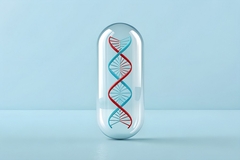IFF presents strategies to target GLP-1 consumer needs with new F&B solutions

A new report by IFF details how the rapidly growing GLP-1 weight loss consumer market is reshaping the sensory experience and nutritional needs associated with eating and drinking. The ingredient specialist outlines how food and beverage manufacturers can better support this emergent consumer segment with products aligning with evolving preferences.
The outlook also outlines how each GLP-1 consumer’s food and beverage (F&B) needs evolve. In the initial treatment phase, consumers need support managing smaller portion sizes and medication side effects.
Next, the “transitional” phase focuses on preventing regression, requiring flexible serving sizes and flavor intensity options that adapt to changing cravings.
In the “forever” phase, consumers seek to sustain their new routines with habit-forming formats for daily use, nutritional fortification, and pre-portioned, high-satiety foods.
“IFF is empowering our customers to lead the next wave of (F&B) innovations beyond traditional formulations, including helping GLP-1 consumers have choices they desire,” says Erik Fyrwald, IFF CEO. “We aim to bring back the joy of eating and drinking by offering more healthy, great-tasting nutrition choices for all consumer segments, including GLP-1 users.”
Evolving taste preferences
IFF highlights that GLP-1 users are “eating less but require more from every bite and sip.” The report stresses they need nutrient-dense, smaller portions that efficiently deliver protein, fiber and hydration — without “overwhelming” flavors.
Notably, 85% of GLP-1 consumers report significant changes in their food and beverage preferences. Common aversions include fatty foods, sweets, deli meats, coffee, and alcohol. Dry, sticky, or dense textures are also frequently rejected.
On the emotional front, many consumers are navigating a changed relationship with food — one that may involve a sense of loss, social disruption, and a “search for new meaning in nourishment.”
Early stages of GLP-1 consumer segmentation
IFF is in the early stages of exploring GLP-1 consumer segmentation to help brands move “beyond a one-size-fits-all approach toward one grounded in empathy, specificity, and long-term relevance.”
The company’s latest outlook introduces three key consumer personas that it expects will evolve:
- Health Hacker Holly: Proactive, data-driven, and focused on long-term wellness, she views GLP-1 as part of a broader bio-optimization journey. She seeks functional benefits in formats such as protein bars, smoothies, and enriched hydration blends, prioritizing high-quality protein, added fiber, and digestive support.
- Remedy Reacher Ron: Often managing chronic conditions such as diabetes, he uses GLP-1 to reclaim his health and sees food as both medicine and maintenance. He looks for fortified snacks and gut-friendly options aligned with medical guidance, favoring meal kits and low-glycemic shakes.
- Glow Getter Gail: Transformation-minded and focused on lifestyle and self-image, she wants food that aligns with her goals and identity — aspirational yet approachable, with “glow-up” appeal. She seeks portion-conscious indulgences, beauty-boosting nutrition, and enjoyable flavors in smoothies, functional waters, and shareable treats.
IFF has developed a suite of AI-refined, consumer-tested product concepts that show how manufacturers can optimize their portfolios for this rapidly expanding market.
Spotlight on GLP-1 in product applications
Despite the rapid rise in GLP-1 medication use, IFF underscores that most (F&B) products fall short of meeting consumer needs. Previous studies have affirmed that GLP-1 therapies may weaken taste while causing significant nutritional gaps and muscle loss as a result of reduced cravings.
Notable examples of brands that have made a foray into the GLP-1 space with nutrient-packed, high-protein offerings include Nestlé’s Vital Pursuit product line. On the digital side, newly launched AI-based platforms are offering consumers a way of keeping track of nutritional targets more effectively throughout their rapid weight loss journey.
In other recent advances in this field, Swedish researchers at the Sahlgrenska Academy of the University of Gothenburg uncovered a specific group of nerve cells in the brain stem that appears to control how the anti-diabetic medication semaglutide affects appetite and weight — without causing nausea like traditional GLP-1 medications.












